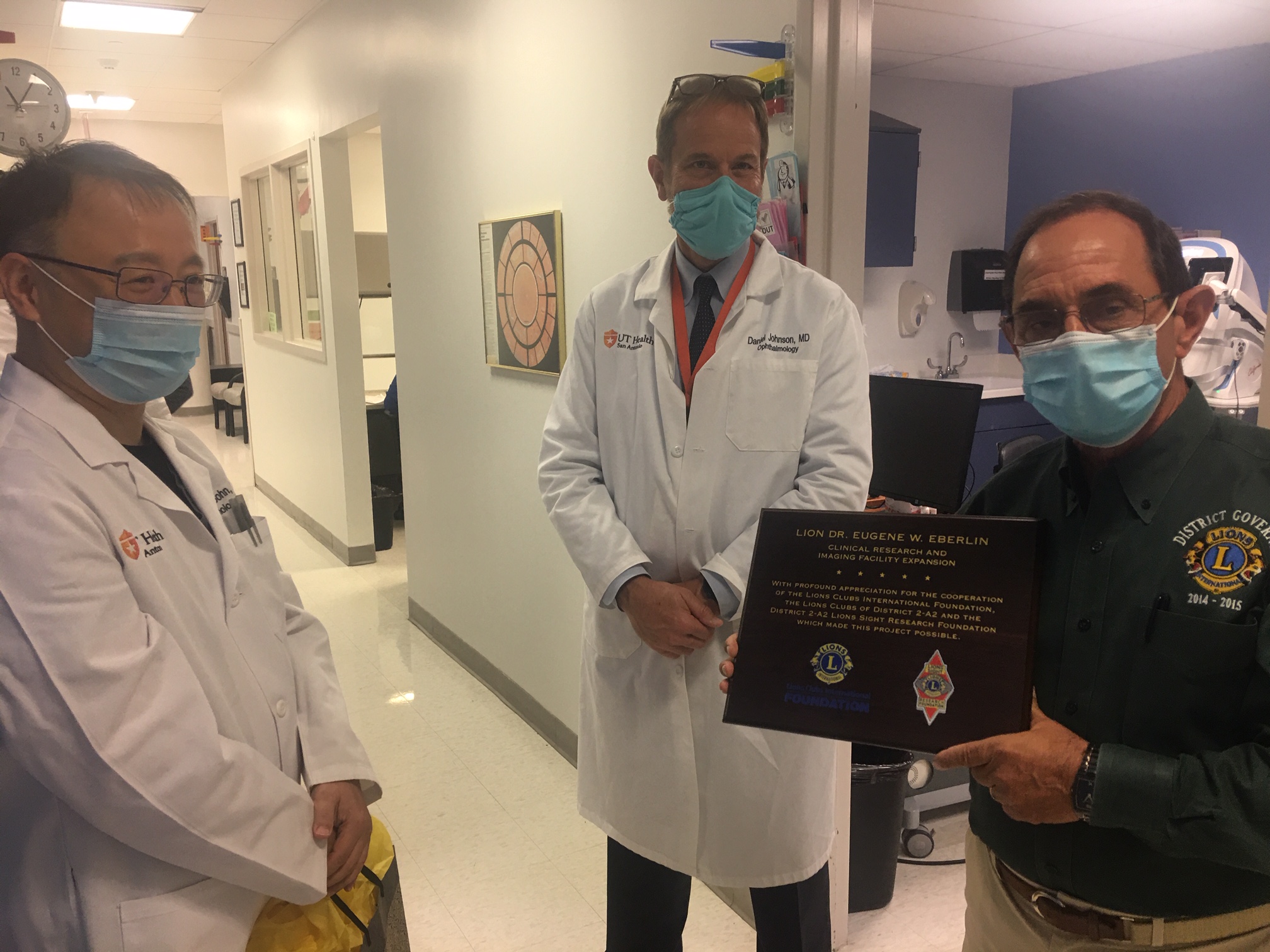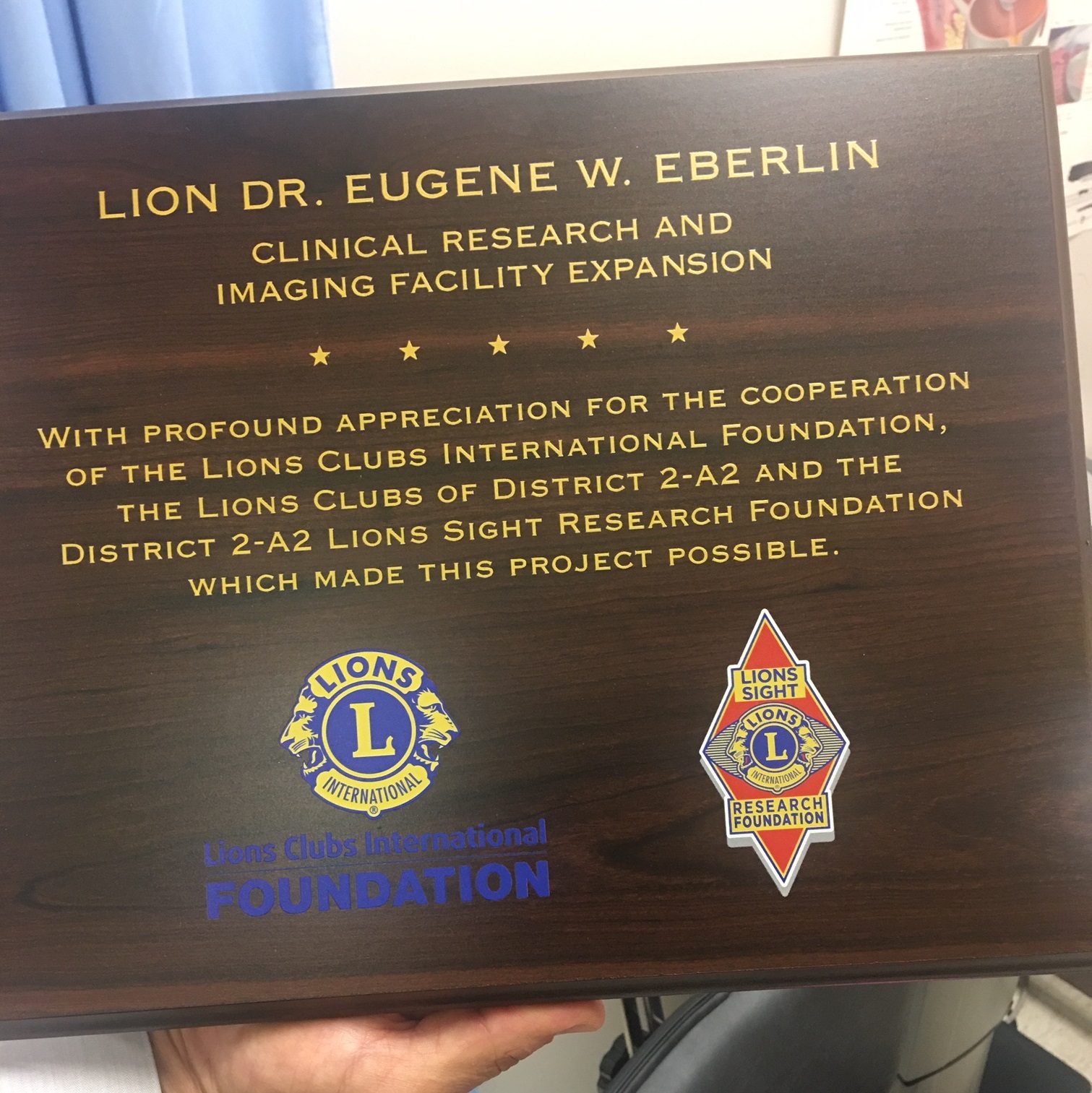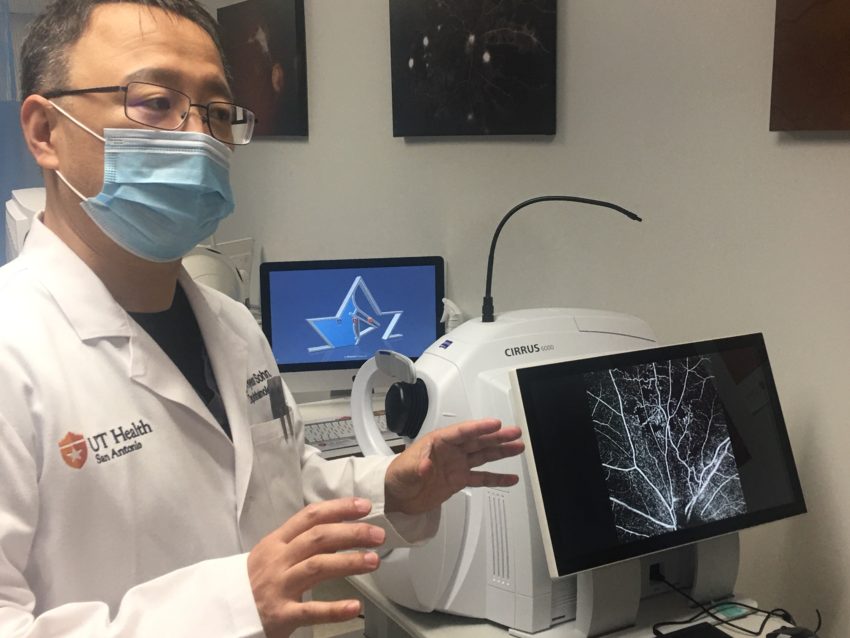Wide-field camera enables testing for diabetic retinopathy over more of the retina.
The Lions Clubs International Foundation, in collaboration with South and Central Texas Lions Club members of District 2-A2, have increased their commitment to the prevention of blinding eye diseases with a $150,000 gift to UT Health San Antonio’s Department of Ophthalmology.
The gift, augmented by $50,000 from UT Health San Antonio, recently expanded the Lion Dr. Eugene W. Eberlin Clinical Research and Imaging Facility at the Texas Diabetes Institute (TDI) Ophthalmology Clinic. The TDI, a partnership of University Health and UT Health San Antonio, is located at the University Center for Community Health, 701 S. Zarzamora St.
The 47 Lions Clubs in San Antonio and surrounding counties participated in raising funds for this vision-saving project, along with other clubs in District 2-A2.
The renovated Eberlin Facility now includes:
* An ultra-wide retinal fundus camera that increases clinicians’ ability to diagnose diabetic retinopathy, the leading cause of blindness in working-age adults. The retina is the tissue lining the back of the eye that senses light and sends visual information via the optic nerve to the brain, where an image is formed.
* A unit to perform optical coherence tomography (OCT) angiography, which complements the fundus camera and makes it possible to non-invasively detect retinal blood circulation.
* An additional eye examination lane, increasing by 1,500 the number of comprehensive evaluations that can be performed annually and decreasing patient wait time.
“We live by the phrase, ‘Where there is a need, there is a Lion,’” said Lion Sam Pantusa, president and chief operating officer of the Lions Sight Research Foundation, which is supported by the 64 Lions Clubs in District 2-A2, Texas. “The most primary of our areas of service is to help the blind and visually impaired. The expansion of the Eberlin Facility is a wonderful project to help the highly regarded ophthalmic researchers and physicians serve our fellow community members who are suffering with diabetic retinopathy.”

“This expansion through the great generosity of the local Lions, in collaboration with the Lions Clubs International Foundation, will allow us to continue our research, make eye care safer during the COVID-19 pandemic, and provide incredible diagnostics for our patients,” said Daniel Johnson, MD, professor and chairman of ophthalmology in the UT Health San Antonio’s Joe R. and Teresa Lozano Long School of Medicine.
The TDI is located in a medically underserved area of San Antonio’s West Side with high prevalence of diabetes and diabetic retinopathy.
The TDI Ophthalmology Clinic conducted about 23,000 patient visits annually before the expansion and will now be able to reach 24,500.
Imaging of the eye is imperative to identify changes in blood vessels, including thickening of the vascular layers, capillary non-perfusion, leakage of plasma proteins, ischemia and proliferation of new vessels. One mode of imaging is called fundus color photography.
“The Lions’ valuable support enabled the purchase of a wide-field fundus camera that allows a 200-degree view of the retina, compared to a 30-degree view afforded by our previous camera,” said Jeong-Hyeon “John” Sohn, MD, director of the TDI Ophthalmology Clinic and the Retina Division of the Department of Ophthalmology.
“Not only can the new unit take images through a non-dilated pupil, but it can capture up to 82% of the retina in a single image,” Dr. Sohn said. “This allows our clinicians to see at least 50% more of the retina, which is essential to diabetic retinopathy evaluation and management.”

Both the fundus camera and the OCT angiography instrument enable earlier detection of diabetic retinopathy, which typically begins years before it is diagnosed, causing irreversible damage.
The imaging is easier and quicker for patients, because both pupil dilation and injection of dye to obtain images are no longer needed.
“Interestingly, we are starting a clinical study to see the effect of specific diabetes medications on diabetic retinopathy progression using the wide-field fundus camera,” Dr. Sohn said.
“Words can’t really express how grateful we are to the local and international Lions for providing this expansion, which will enhance our research and patient care missions,” Dr. Johnson said.
# # #
The Long School of Medicine at The University of Texas Health Science Center at San Antonio is named for Texas philanthropists Joe R. and Teresa Lozano Long. The school is the largest educator of physicians in South Texas, many of whom remain in San Antonio and the region to practice medicine. The school teaches more than 900 students and trains 800 residents each year. As a beacon of multicultural sensitivity, the school annually exceeds the national medical school average of Hispanic students enrolled. The school’s clinical practice is the largest multidisciplinary medical group in South Texas with 850 physicians in more than 100 specialties. The school has a highly productive research enterprise where world leaders in Alzheimer’s disease, diabetes, cancer, aging, heart disease, kidney disease and many other fields are translating molecular discoveries into new therapies. The Long School of Medicine is home to a National Cancer Institute-designated cancer center known for prolific clinical trials and drug development programs, as well as a world-renowned center for aging and related diseases.
The University of Texas Health Science Center at San Antonio, also referred to as UT Health San Antonio, is one of the country’s leading health sciences universities and is designated as a Hispanic-Serving Institution by the U.S. Department of Education. With missions of teaching, research, patient care and community engagement, its schools of medicine, nursing, dentistry, health professions and graduate biomedical sciences have graduated more than 37,000 alumni who are leading change, advancing their fields, and renewing hope for patients and their families throughout South Texas and the world. To learn about the many ways “We make lives better®,” visit www.uthscsa.edu.
Stay connected with The University of Texas Health Science Center at San Antonio on Facebook, Twitter, LinkedIn, Instagram and YouTube.
To see how we are battling COVID-19, read inspiring stories on Impact.
About the Texas Diabetes Institute
Through a multidisciplinary approach to treatment, health promotion, patient education, professional training and research, the Texas Diabetes Institute, TDI, represents America’s largest and most comprehensive center completely dedicated to the prevention and treatment of diabetes. As a collaboration between University Health and UT Health San Antonio, the Texas Diabetes Institute is directed and staffed by world-renowned specialists and equipped with the most advanced medical technology. This facility is designed to provide unsurpassed continuum of care for patients with diabetes mellitus and to conduct research to seek a cure for this debilitating disease. It is our mission to ensure healthier, happier and more fulfilling lives for thousands of men, women and children facing diabetes. Diabetes & Endocrinology Services | University Health


